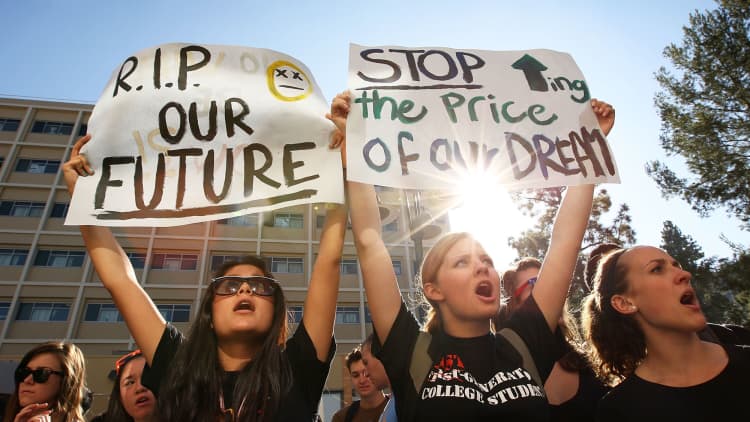Over the past 30 years, average college tuition and fees increased from $3,800 to $10,560 at four-year public universities and from $18,560 to $37,650 at non-profit private universities. But external costs, such as books, housing and transportation also contribute to the financial difficulties facing today's college students.
For the country's older college students, who make up a significant share of U.S. college enrollment, these external costs can be especially burdensome.
According to a recent report from the Georgetown Center on Poverty and Inequality, college students ages 25-45 spend $30,900 per year on costs other than tuition, on average.
Today, roughly 6.6 million Americans ages 25 to 45 are working on their college degree and there are approximately 36 million Americans who started college but never graduated — and may one day return. These "nontraditional" learners are disproportionately Black, Latinx and lower earning. They are also more likely to have children.
"The real cost of college for students is higher than commonly understood. Tuition costs, which have risen rapidly during the past three decades, tend to drive much of the debate about college affordability. However, living costs for students — such as housing, food, and transportation — are far more dominant components of the cost of attending college," reads the report. "For older students, average annual costs beyond tuition are nearly three times larger than the average annual cost of in-state tuition at public four-year colleges, and more than eight times larger than the average annual tuition for public two-year colleges. Understanding and addressing costs beyond tuition is essential to ensuring college is affordable for all students."
For the report, researchers considered costs such as child care, health care, transportation and food. Housing was the biggest expense, with older students spending about $12,400 per year on average. Researchers found that older students were more than three times more likely to experience homelessness compared to their younger classmates.
Vincent Palacios, a senior policy analyst at the Georgetown Center on Poverty and Inequality and lead author of the report says that the findings can give college administrators and policymakers better insight into how they can fully support college students.
While many older students work while earning their degree, Palacios recommends expanding on-campus work-study opportunities for older students, arguing that this could reduce transportation times and make child care logistics easier. He also suggests increasing funding for non-tuition assistance.
"The current financial aid and public benefits systems that should be helping older students afford the cost of attendance are inadequate because they don't fully capture the additional costs that older students face," he says. "We need to appreciate the actual cost that these students face so that we can help them fully afford it. And so that they can then go on to complete college, complete affordably and enjoy some economic mobility as a result."
He adds that while it's important to address the issues that face traditionally aged college students, supporting older college students is an especially important tool to help address inequality and maintain the United States labor market's competitiveness.
"We should recognize the initiative that older students have shown. They've persisted in higher education. We're looking at students who, most likely were delayed in enrollment, but kept coming back. And they're doing so despite the barriers in front of them. And we should reward that initiative," he says. "We also need to care about these students because we all want a society where there's more than one pathway to success."
Don't miss:



